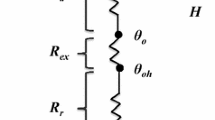Summary
The influence of variations in the boundary air layer thickness on transpirtion due to changes in leaf dimension or wind speed was evaluated at a given stomatal resistance (r s) for various combinations of air temperature (T a) and total absorbed solar energy expressed as a fraction of full sunlight (S ffs). Predicted transpiration was found to either increase or decrease for increases in leaf size depending on specific combinations of T a, S ffs, and r s. Major reductions in simulated transpiration with increasing leaf size occurred for shaded, highly reflective, or specially oriented leaves (S ffs=0.1) at relatively high T a when r s was below a critical value of near 500 s m-1. Increases in S ffs and decreases in T a lowered this critical resistance to below 50 s m-1 for S ffs=0.7 and T a=20°C. In contrast, when r s was above this critical value, an increase in leaf dimension (or less wind) resulted in increases in transpiration, especially at high T a and S ffs. For several combinations of T a, S ffs, and r s, transpiration was minimal for a specific leaf size. These theoretical results were compared to field measurements on common desert, alpine, and subalpine plants to evaluate the possible interactions of leaf and environmental parameters that may serve to reduce transpiration in xeric habitats.
Similar content being viewed by others
References
Billings WD (1974) Adaptations and origins of alpine plants. Arct Alp Res 6:129–142
Drake BG, Raschke K, Salisbury RB (1970) Temperatures and transpiration resistances of Xanthium leaves as affected by air temperature, humidity and wind speed. Plant Physiol 46:324–330
Ehleringer J, Bjorkman O, Mooney HA (1976) Leaf pubescence: effects on absorptance and photosynthesis in a desert shrub. Science 192:376–377
Gates DM (1976) Energy exchange and transpiration. In: Lange OL, Kappen L, Schulze E-D (eds) Ecological studies, Vol. 19: Water and plant life. Springer, Berlin Heidelberg New York pp 137–147
Gates DM, Papian LE (1971) Atlas of energy budgets of plant leaves. Academic Press, New York
Korner Ch, DeMoraes JAPV (1979) Water potential and diffusion resistance in alpine cushion plants on clear summer days. Oecol Plant 14:109–120
Korner Ch, Scheel JA, Bauer H (1979) Maximum leaf diffusive conductance in vascular plants. Photosynthetica 13:45–82
Lindsay JH (1971) Annual cycle of leaf water potential in Picea engelmannii and Abies lasiocarpa at timberline in Wyoming. Arct Alp Res 3:131–138
Marchand PJ (1972) Wind and the winter-exposed plant. Rhodora 74:528–531
Marchand PJ, Chabot BF (1978) Winter water relations of treeline plant species on Mt. Washington, New Hampshire. Arct Alp Res 10:105–116
Miller PC (1972) Bioclimate, leaf temperature, and primary production in red mangrove canopies in South Florida. Ecology 53:22–45
Nobel PS (1974) Biophysical plant physiology. Freeman, San Francisco
Parkhurst DF, Loucks OL (1972) Optimal leaf size in relation to environment. J Ecol 60:505–537
Raschke K (1956) Über die Physikalischen Beziehungen zwischen Wärmeübergangszahl, Strahlungsaustausch, Temperatur, und Transpiration eines Blattes. Planta 48:200–238
Smith WK (1978) Temperatures of desert plants: another perspective on the adaptability of leaf size. Science 201:614–616
Smith WK, Miller PC (1973) The thermal ecology of two South Florida fiddler crabs: Uca rapax Smith and Uca pugilator Bosc. Physiol Zool 46:186–207
Smith WK, Nobel PS (1977a) Influences of seasonal changes in leaf morphology on water-use efficiency for three desert broadleaf shrubs. Ecology 58:1033–1043
Smith WK, Nobel PS (1977b) Temperature and water relations for sun and shade leaves of a desert broadleaf, Hyptis emoryi. J Exper Bot 28:169–183
Taylor SE (1975) Optimal leaf form. In: Gates DM, Schmerl RB (eds) Ecological Studies, Vol. 12: Perspectives of biophysical ecology. Springer-Verlag, Berlin Heidelberg New York. pp 73–86
Tibbals EC, Carr EK, Gates DM, Kreith F (1964) Radiation and convection in conifers. Am J Bot 51:529–538
Tiffney WN Jr (1972) Snow cover relationships of White Mountain alpine plants. Ph.D. Thesis, University of New Hampshire, Durham
Author information
Authors and Affiliations
Rights and permissions
About this article
Cite this article
Smith, W.K., Geller, G.N. Leaf and environmental parameters influencing transpiration: Theory and field measurements. Oecologia 46, 308–313 (1980). https://doi.org/10.1007/BF00346257
Received:
Issue Date:
DOI: https://doi.org/10.1007/BF00346257




